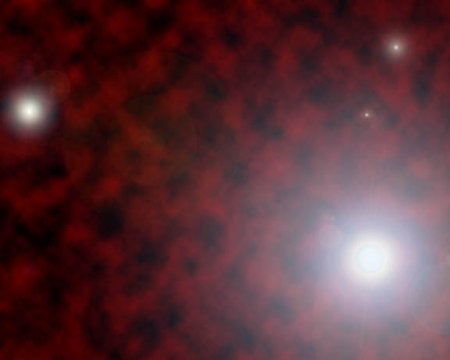For decades, cosmologists have been pushing back our understanding of the universe to ever-earlier epochs. The ultimate quest, however, is to unlock the mystery of when the young universe was in the midst of what astronomers call the “Dark Ages.” Now, two theoretical cosmologists think they have found a way to lift the cosmic fog and illuminate a time before even the first stars and galaxies ignited.
Theorists Abraham Loeb and Matias Zaldarriaga from the Harvard-Smithsonian Center for Astrophysics in Cambridge, Massachusetts, are answering this simple yet puzzling question: How do you observe what existed before the first stars began to light up the cosmos? Drawing up the first detailed solution to this problem, the team has calculated that it should be possible to detect the very first atoms in the early universe by looking for the shadows they cast.
The ability to decipher these shadows rests on radio-wavelength observations of the highly redshifted photons left over from the Big Bang called the cosmic microwave background (CMB) radiation. “There is an enormous amount of information imprinted on the microwave sky that could teach us about the initial conditions of the universe with exquisite precision,” says Loeb.
Putting the current expansion of the universe in reverse and tracing it back in time leads to the conclusion that for the first few hundred thousand years after the Big Bang, a dense fog of ionized gas existed. Significant cooling followed thereafter, allowing atoms of hydrogen to form. Clumping together to form enormous clouds, this hydrogen absorbed all light energy, shrouding the universe when it was only 20 to 100 million years old. By using a newly developed shadow technique that can reveal regions with fewer photons that are colder than the surrounding CMB, primordial hydrogen clumps as small as 30,000 light-years across could be mapped. This observational method betters previous instruments, like the Wilkinson Microwave Anisotropy Probe (WMAP), by a factor of one thousand.
“This method offers a window into the physics of the very early universe, namely the epoch of inflation during which fluctuations in the distribution of matter are believed to have been produced,” explains Loeb. “Moreover, we could determine whether neutrinos or some unknown type of particle contribute substantially to the amount of ‘dark matter’ in the universe. These questions — what happened during the epoch of inflation and what is dark matter — are key problems in modern cosmology whose answers will yield fundamental insights into the nature of the universe.”
Reporting their theory in an upcoming issue of Physical Review Letters, Loeb and Zaldarriaga believe that the main challenge in detecting these signals will involve the low frequencies where terrestrial sky-noise is high and Earth’s atmosphere is naturally opaque, making space-based instruments the best way to avoid these nuisances. In the meantime, hopes are riding on the next generation of radio telescopes to be the first to detect these ancient cosmic shadows starting with the Low Frequency Array (LOFAR), which is scheduled to begin the search in 2006.
“There’s a gold mine of information out there waiting to be extracted. While its full detection may be experimentally challenging, it’s rewarding to know that it exists and that we can attempt to measure it in the near future,” says Loeb.










